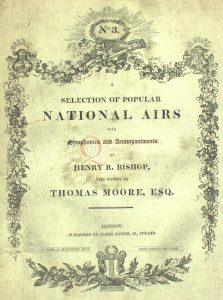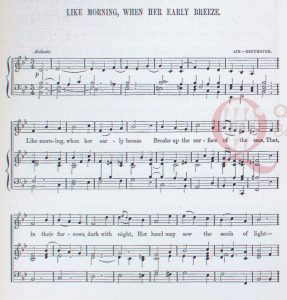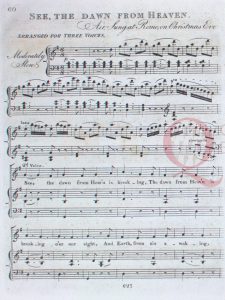In the previous post we considered Moore’s regular music activities as an appreciative auditor, a well-received performer, and a keen music copyist. This blog will explore the intersection between Moore’s social experience of music and his professional use of it. For Moore, the process of performing songs as he was working on them–and also after they were published as a means of promoting sales — was an established practice. On one occasion over a six-week period we we see him creating lyrics to an instrumental notturne by the contemporary Italian composer Giuseppe Felice Blangini (1781-1841), and testing the piece out in performance with a social acquaintance Miss Canning before sending it off to his usual music publisher James Power.
Decorative book cover from Moore and Henry Bishop’s National Airs, number 3
At times Moore’s Journal is frustratingly sketchy — for example, on 29 July 1822 he merely tells us: “sent off today to Power the slight sketch of a Song to a little air of Beethoven’s”. (Given the date, this probably refers to ‘Like morning, when her early Breeze’ from number 2 of his Sacred Songs, as it came out in 1824.) On other occasions, however, we get some indication how Moore’s creative processes were stimulated. From a series of Journal entries we can glean the story of Moore’s discovery of an air by Neapolitan composer Michele Enrico Carafa, “O Cara Memoira” and his eventual success at writing lyrics for it. Moore first encountered this tune on 31 October 1824 at the Bowood residence of his patron Lord Lansdowne, where Lady Pembroke sang it and Moore was immediately moved to copy it out. On 15-16 November he reported a lack of success at putting words to the song; inspiration struck on 11 January 1825 when, upon walking to Bowood from his own cottage, Moore “wrote a verse of a song to Carafa’s beautiful air in going” [i.e. during his walk]. And so by mid-January a new song was ready to send to James Power.
Opening bars of Moore’s lyrics and Henry Bishop’s arrangement of Beethoven’s ‘Like Morning when her early breeze’ from Sacred Songs, number 2.
In a similar tale of inspiration, Moore records hearing Ferdinando Paer and his daughter sing at the Comte de Flahaut’s residence during his Paris sojourn (23 Dec. 1819); he was struck by their rendition with Flahaut of a “very pretty” trio, a harmonization by Paer of “an air that they sing to bagpipes at Rome in Christmas time”. Moore resolved that he “must have it for my National Melodies” (Dowden has identified this as ‘See, the Dawn from Heaven’ from number 3 of Moore’s National Airs). Moore, who was generally a ‘chatty’ writer in both his journal and in his letters, has likely left us more tales of interest to discover over the course of our project.
Opening bars of Moore and Henry Bishop’s arrangement of the Roman bagpipe air, National Airs, number 3.
Images courtesy of Special Collections, McClay Library, Queen’s University Belfast.



